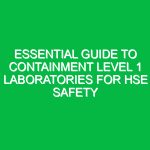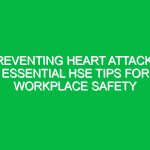Introduction
In today’s rapidly evolving industrial landscape, the paramount importance of health, safety, and environmental (HSE) standards cannot be overstated. One of the fundamental concepts within this realm is the “controlled risk definition.” This term refers to the process of identifying and managing risks to ensure they remain within acceptable levels, thereby safeguarding the health and Safety of workers and the Environment. Understanding this definition and its implications is crucial for organizations aiming to foster a culture of Safety and Sustainability.
Defining Controlled Risk in HSE
At its core, the controlled risk definition in HSE encompasses the systematic approach to risk management. It includes identifying potential Hazards, assessing the risks associated with those Hazards, and implementing measures to mitigate them. This process not only aims to minimize the likelihood of accidents and incidents but also seeks to enhance overall operational efficiency. In essence, controlled risk management ensures that risks are understood, monitored, and managed rather than ignored or left to chance.
Key Components of Controlled Risk Definition
Understanding the controlled risk definition requires delving into several key components:
1. Risk Identification
The first step in controlled risk management is identifying potential hazards that could adversely affect health, safety, and the environment. This process often involves systematic inspections, employee feedback, and reviewing historical data. For example, in a manufacturing plant, risks may include machinery malfunctions, chemical spills, or ergonomic hazards.
2. Risk Assessment
Once hazards are identified, the next step is to assess the associated risks. This involves evaluating both the likelihood of an incident occurring and the potential consequences. Tools such as risk matrices can be employed to categorize risks based on their severity and probability. A real-life scenario could involve assessing the risk of a chemical exposure incident in a laboratory setting. By evaluating the potential impact on health and safety, organizations can prioritize their response efforts.
3. Risk Control Measures
After assessing risks, organizations must implement Control Measures to mitigate them. These can range from engineering controls, such as installing safety guards on machinery, to administrative controls, like implementing safety Training programs. Effective control measures not only reduce risks but also promote a culture of safety within the workplace. For instance, regular safety drills can prepare employees to respond effectively in case of an emergency.
4. Monitoring and Review
Risk management is an ongoing process. After implementing control measures, it is essential to monitor their effectiveness and make adjustments as necessary. Regular audits and reviews can help organizations identify new risks that may emerge and ensure that existing controls remain relevant. For example, if a new piece of equipment is introduced, a reassessment of risks and controls is vital to maintain safety Standards.
Benefits of Controlled Risk Management in HSE
Implementing a robust controlled risk definition framework offers numerous Benefits:
- Enhanced Safety: By systematically managing risks, organizations can significantly reduce the likelihood of accidents and injuries.
- Regulatory Compliance: Adhering to controlled risk management practices helps organizations comply with various health and safety Regulations.
- Increased Productivity: A safer workplace fosters employee morale and productivity, leading to improved overall performance.
- Reduced Costs: By preventing accidents and incidents, organizations can minimize costs associated with workers’ compensation, legal fees, and damage to property.
Real-Life Examples of Controlled Risk Management
To illustrate the concept of controlled risk definition, consider the case of a construction company that faced significant safety challenges. After conducting a thorough risk assessment, they identified falls from heights as a critical hazard. In response, the company implemented a series of control measures, including installing guardrails, providing harnesses, and conducting regular safety training sessions. Over time, these measures led to a marked decrease in fall-related incidents, showcasing the effectiveness of a well-defined controlled risk management strategy.
Regulations and Standards Governing Controlled Risk Definition
Various regulations and standards govern the practices surrounding controlled risk management in HSE. These include:
- Occupational Safety and Health Administration (OSHA): In the United States, osha sets forth regulations that require employers to identify and mitigate workplace hazards.
- ISO 45001: This international standard focuses on Occupational Health and safety management systems, emphasizing the need for risk management.
- Environmental Protection Agency (EPA): The EPA regulates environmental risks, ensuring that organizations adhere to safety standards that protect public health and the environment.
These regulations not only provide a framework for implementing controlled risk definition but also hold organizations accountable for maintaining safety standards.
Best Practices for Implementing Controlled Risk Management
To effectively implement a controlled risk definition framework, organizations should consider the following Best Practices:
- Engage Employees: Involve employees in the risk assessment process. Their firsthand knowledge can provide valuable insights into potential hazards.
- Use Technology: Leverage technology, such as risk management software, to streamline the risk management process and enhance data analysis.
- Continuous Training: Regularly update training programs to reflect changes in policies, procedures, and equipment.
- Foster a Culture of Safety: Encourage open communication about safety concerns and promote a culture where employees feel empowered to report hazards.
Challenges in Controlled Risk Management
Despite the numerous benefits, organizations may encounter challenges when implementing controlled risk management strategies:
- Resistance to Change: Employees may resist new safety protocols, leading to ineffective implementation.
- Resource Constraints: Limited budgets can hinder the ability to invest in necessary safety equipment and training.
- Complex Regulations: Navigating the myriad of regulations can be overwhelming for organizations, particularly smaller businesses.
Addressing these challenges requires a commitment from leadership and a willingness to foster a culture of safety throughout the organization.
Conclusion
In conclusion, the controlled risk definition is a vital aspect of health, safety, and environmental management. By understanding and implementing a structured approach to risk management, organizations can enhance safety, ensure regulatory compliance, and promote sustainable practices. The journey towards effective controlled risk management is continuous, requiring ongoing evaluation and adaptation to changing circumstances. As the industrial landscape evolves, so too must our strategies for managing risks, ensuring a safe and sustainable future for all. By prioritizing health, safety, and environmental sustainability, organizations not only protect their employees but also contribute to the well-being of the communities in which they operate.


